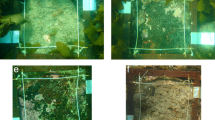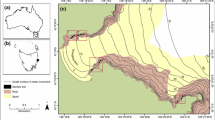Abstract
Stability properties of the barren state of a kelp forest-sea urchin system were studied in northern Norway. The ability of the sea urchin Strongylocentrotus droebachiensis to maintain high population densities and recover from perturbations, and the succession of kelp forest revegetation, were studied experimentally by reducing the sea urchin density on a barren skerry. Additional information was obtained from community changes following a natural, but patchy, sea urchin mortality that varied between sites. On the barren grounds, high sea urchin densities (30 50 per m2) is maintained by annual recruitment. Severe reductions of sea urchin densities initiated luxuriant kelp growth, while more moderate reductions allowed establishment of opportunistic algae (during spring and early summer), but no kelps. Succession of algal growth, after the severe decline in sea urchin densities, followed a predictable pattern. At first the substrate was colonized by filamentous algae, but within few weeks they were outcompeted by the fast growing kelp Laminaria saccharina. After 3–4 years of the removal experiment, the slower-growing, long-lived kelp L. hyperborea became increasingly dominant. Increased food availability after reduction in sea urchin density led to increased individual growth of the remaining sea urchins. However, the population density did not increase, neither from recruitment nor immigration from adjacent areas with high sea urchin densities. Possibly, early establishment of a dense kelp stand, may represent a breakpoint in the ability of sea urchins to reestablish a barren state. The ability of L. saccharina quickly to invade and monopolize an area may have both positive and negative effects on the succession towards the climax L. hyperborea kelp forest. Competitive interactions may slow the process, but development of a dense stand of L. saccharina will also reduce grazing risk on scattered recruits of the more slowly growing L. hyperborea.
Similar content being viewed by others
References
Bernstein BB, Welsford RW (1982) An assessment of feasibility of. using high-calcium quicklime as an experimental tool for research into kelp bed/sea urchin ecosystems in Nova Scotia. Can Tech Rep Fish Aquat Sci 968: 1–51
Boudouresque CF, Nedelec N, Sheperd SA (1980) The decline of a population of the sea urchin Paracentrotus lividus in the Bay of Port-Cros (Var, France). Trav Sci Parc Nat Port-Cros 6: 243–251
Breen PA, Mann KH (1976) Destructive grazing of kelp beds by sea urchins in eastern Canada. J Fish Res Bd Can 33: 1278–1283
Chapman ARO (1981) Stability of sea urchin dominated barren grounds following destructive grazing of kelp in St. Margaret's Bay, eastern Canada. Mar Biol 62: 307–311
Christie HC, Leinaas HP, Skadsheim A (1995) Local patterns in mortality of the green sea urchin, Strongylocentrotus droebachiensis, at the Norwegian coast. In: Skjoldal HR, Hopkins CCE, Erikstad KE, Leinaas HP (eds) Ecology of fjords and coastal waters. Elsevier, Amsterdam, pp 571–582
Connell JH, Sousa WP (1983) On the evidence needed to judge ecological stability or persistence. Am Nat 121: 789–824
Dayton PK (1985) Ecology of kelp communities. Annu Rev Ecol Syst 16: 215–245
Dayton PK, Tegner MJ, Parnell PE, Edwards PB (1992) Temporal and spatial patterns of disturbance and recovery in a kelp forest community. Ecol Monogr 62: 421–445
Duggins DO (1980) Kelp beds and sea otters: an experimental approach. Ecology 61: 447–453
Gagnon J-M, Gilkinson KD (1994) Discrimination and distribution of the sea urchins Strongylocentrotus droebachiensis (OF Müller) and S. pallidus (GO Sars) in the Northwest Atlantic. Sarsia 79: 1–11
Grenager B (1955) Quantitative investigations on the occurence of kelps in Sør-Helgeland in 1952 and 1953 (In Norwegian). Nor Inst Tang Tareforsk Rep 7: 1–70
Hagen NT (1983) Destructive grazing of kelp beds by sea urchins in Vestfjorden, northern Norway. Sarsia 68: 177–190
Hagen NT (1987) Sea urchin outbreaks and nematode epizootics in Vestfjorden, northern Norway. Sarsia 72: 213–229
Harris LG (1981) Studies of community succession in a sea urchin barrens area following sea urchin removal. Am Zool 21: 1019
Himmelman JH, Cardinal A, Bourget E (1983) Community development following removal of urchins, Strongylocentrotus droebachiensis, from the rocky subtidal zone of the St. Lawrence Estuary, eastern Canada. Oecologia 59: 27–39
Jensen M (1969) Age determination of echinoids. Sarsia 37: 41–44
Jensen M (1974) The Strongylocentridae (Echinoidea), a morphologic and systematic study. Sarsia 57: 113–158
Johnson CR, Mann KH (1982) Adaptions of Strongylocentrotus droebachiensis for survival on barren grounds. In: Lawrence JM (ed) Echinoderms: proceedings of the international conference, Tampa Bay. Balkema, Rotterdam, pp 277–283
Johnson CR, Mann KH (1988) Diversity, patterns of adaptation, and stability of Nova Scotian kelp beds. Ecol Monogr 58: 129–154
Jones NS, Kain JM (1967) Subtidal algal colonization following the removal of Echinus. Helgoländ wiss Meeresunters 15: 460–466
Jones GM, Scheibling RE (1985) Paramoeba sp. (Amoebida, Paramoebidae) as the possible causative agent of sea urchin mass mortality in Nova Scotia. J Parasitol 71: 559–565
Kain JM (1963) Aspects of the biology of Laminaria hyperborea. II. Age, weight and length. J Mar Biol Assoc UK 43: 129–151
Kain JM (1971) The biology of Laminaria hyperborea. VI. Some Norwegian populations. J Mar Biol Assoc UK 51: 387–408
Keats DW (1991) Refugial Laminaria abundance and reduction in urchin grazing in communities in the North-West Atlantic. J Mar Biol Assoc UK 71: 867–876
Keats DW, South GR, Steele DH (1990) Effects of an experimental reduction in grazing by green sea urchins on a benthic macroalgal community in eastern Newfoundland. Mar Ecol Prog Ser 68: 181–193
Lang C, Mann KH (1976) Changes in sea urchin populations after the destruction of kelp beds. Mar Biol 36: 321–326
Levin SA (1992) The problem of pattern and scale in ecology. Ecology 73: 1943–1967
Lüning K (1990) seaweeds Their environment, biogeography and ecophysiology. Wiley, New York
Mann KH (1977) Destruction of kelp-beds by sea urchins: a cyclical phenomenon or irreversible degradation?. Helgoländ wiss Meeresunters 30: 455–467
May RM (1977) Thresholds and breakpoints in ecosystems with a multiplicity of stable states. Nature 269: 471–477
Miller RJ (1985) Succession in sea urchin and seaweed abundance in Nova Scotia, Canada. Mar Biol 84: 275–286
Miller RJ, Colodey AG (1983) Widespread mass mortalities of the green sea urchin in Nova Scotia, Canada. Mar Biol 73: 263–267
Parke M (1948) Studies on British Laminariaceae. I. Growth in Laminaria saccharina (L.) Lamour. J Mar Biol Assoc UK 27: 651–709
Pearce CM, Scheibling RE (1991) Effect of macroalgae, microbial films, and conspecifics on the induction of metamorphosis of the green sea urchin, Strongylocentrotus droebachiensis (Müller). J Exp Mar Biol Ecol 147: 147–162
Pearce JS, Hines AH (1979) Expansion of a central California kelp forest following the mass mortality of sea urchins. Mar Biol 51: 83–91
Pimm SL (1984) The complexity and stability of ecosystems. Nature 307: 321–326
Pimm SL (1986) Community stability and structure. In: Soulé ME (ed) Conservation biology. Sinauer Sunderland, pp 309–329
Rinde E, Christie H, Fredriksen S, Sivertsen A (1992) Ecological consequences of kelp trawling: importance of the structure of the kelp forest for abundance of fauna in kelp holdfasts, benthic fauna and epiphytes (in Norwegian, English abstract) Nor Inst Nat Res Oppdragsmeld 127: 1–37
Rowley RJ (1990) Newly settled sea urchins in a kelp bed and urchin barren ground: a comparison of growth and mortality. Mar Ecol Prog Ser 62: 229–240
Scheibling R (1986) Increased macroalgal abundance following mass mortalities of sea urchins (Strongylocentrotus droebachiensis) along the Atlantic coast of Nova Scotia. Oecologia 68: 186–198
Scheibling R, Raymond BG (1990) Community dynamics on a subtidal cobble bed following mass motalities of sea urchins. Mar Ecol Prog Ser 63: 127–145
Simenstad CA, Estes JA, Kenyon KW (1978) Aleuts, sea otters, and alternate stable-state communities. Science 200: 403–411
Sivertsen K (1982) Distribution and variation in sea urchin grazing on the kelp forest off the west coast of Norway (in Norwegian). Nordlandsforsk Bodø Rep 7/82: 1–31
Sivertsen K, Bjørge A (1980) Reduction of algal vegetation in Helgeland coastal waters (in Norwegian). Fisk Hav 4: 1–9
Skadsheim A, Christie H, Leinaas HP (1995) Population reductions of Strongylocentrotus droebachiensis (Echinodermata) in Norway and the distribution of its endoparasite Echinomermella matsi (Nematoda). Mar Ecol Prog Ser 119: 199–209
Vadas RL, Elner RW, Garwood PE, Babb IG (1986) Experimental evaluation of aggregation behaviour in the sea urchin Strongylocentrotus droebachiensis. Mar Biol 90: 433–448
Wharton WG, Mann KH (1981) Relationship between destructive grazing by the sea urchin, Strongylocentrotus droebachiensis, and the abundance of American lobster, Homarus americanus, on the Atlantic coast of Nova Scotia. Can J Fish Aquat Sci 38: 1339–1349
Wiens JA (1989) Spatial scaling in ecology. Funct Ecol 3: 385–397
Author information
Authors and Affiliations
Rights and permissions
About this article
Cite this article
Leinaas, H.P., Christie, H. Effects of removing sea urchins (Strongylocentrotus droebachiensis): Stability of the barren state and succession of kelp forest recovery in the east Atlantic. Oecologia 105, 524–536 (1996). https://doi.org/10.1007/BF00330016
Received:
Accepted:
Issue Date:
DOI: https://doi.org/10.1007/BF00330016




